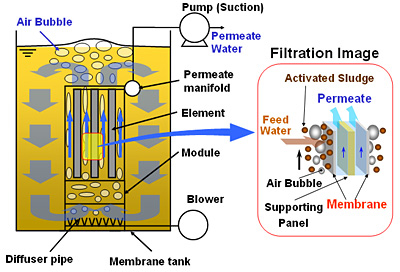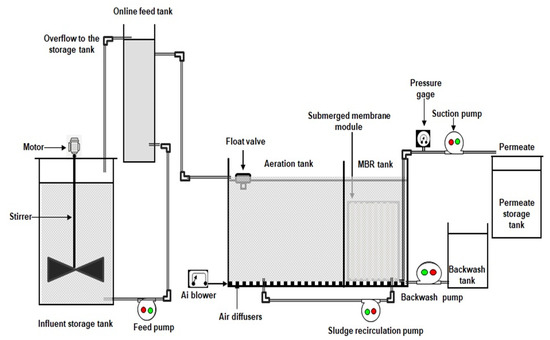How Membrane Bioreactor Can Help Meet Stringent Environmental Regulations
How Membrane Bioreactor Can Help Meet Stringent Environmental Regulations
Blog Article
Membrane Bioreactors Explained: Reliable Solutions for Tidy Water
Membrane layer bioreactors (MBRs) have actually emerged as an advanced option for dealing with the pressing challenges of wastewater treatment. By incorporating organic procedures with innovative membrane purification, MBRs not only boost the top quality of treated water however also reduce the spatial requirements of treatment centers. As ecological worries magnify, the role of MBR modern technology in advertising lasting water management ends up being increasingly substantial. Nonetheless, the intricacies of their operation, benefits, and prospective applications merit a closer exam to completely comprehend their impact on the future of water therapy.

What Are Membrane Bioreactors?
Membrane layer bioreactors (MBRs) are advanced wastewater treatment systems that integrate biological deterioration procedures with membrane layer filtering modern technology. This combination enables the effective elimination of contaminants from water, making MBRs a preferred option in various applications, including municipal wastewater treatment and industrial effluent management.

Among the crucial benefits of MBRs is their ability to generate premium effluent, usually suitable for reuse in watering or commercial procedures. Additionally, MBRs require a smaller footprint contrasted to standard treatment systems, making them perfect for urban setups where area might be restricted.
In addition, MBRs can effectively take care of varying influent loads and are less vulnerable to the impacts of toxic shocks. These features add to their expanding popularity as a lasting solution for dealing with the enhancing need for clean water while minimizing environmental impacts.
How Membrane Bioreactors Work
While the procedure of membrane layer bioreactors (MBRs) might appear complicated, it essentially focuses on the harmony between biological processes and membrane layer purification. MBRs incorporate a biological treatment procedure, typically activated sludge, with a membrane layer splitting up system to deal with wastewater efficiently.
In an MBR system, wastewater is initial presented into a bioreactor where bacteria deteriorate raw material and other pollutants. The biological task lowers the concentration of toxins while promoting the growth of biomass. Following this biological therapy, the combined alcohol is subjected to membrane purification, which can be microfiltration or ultrafiltration, relying on the preferred effluent quality.
The membrane layers work as a physical barrier, permitting water and little solutes to pass while retaining suspended solids and bigger molecules. This makes it possible for the system to preserve a high concentration of biomass within the activator, enhancing the treatment effectiveness.
Additionally, the continuous splitting up of treated water from the biomass facilitates a portable style and reduces the footprint of the treatment center. On the whole, the mix of biological destruction and membrane filtering in MBRs results in trustworthy and efficient wastewater therapy, ensuring top notch effluent ideal for different applications.
Benefits of MBR Modern Technology
One of the crucial benefits of membrane bioreactor (MBR) technology is its ability to generate high-quality effluent with a dramatically reduced footprint compared to conventional wastewater therapy approaches. MBR systems properly integrate organic treatment and membrane purification, causing remarkable removal of contaminants, consisting of suspended solids, virus, and raw material. This capacity results in effluent that frequently meets or exceeds stringent regulatory requirements for reuse and discharge.
Furthermore, MBR technology permits higher biomass focus, which enhances the treatment efficiency and reduces the needed activator volume. This compact style is specifically advantageous in metropolitan locations where space is limited. The operational adaptability of MBR systems also means they can adjust to varying influent qualities and flow prices, making them ideal for a large variety of applications.
Furthermore, the reduced sludge manufacturing related to MBR procedures adds to decrease functional and maintenance prices. The membrane layers work as a physical obstacle, lessening the danger of blocking and making it possible for longer functional periods in between cleansing. Overall, the benefits of MBR modern technology make it an appealing option for lasting wastewater treatment, dealing with both ecological problems and the requirement for reliable resource management.
Applications of Membrane Layer Bioreactors
With their convenience and performance, membrane bioreactors (MBRs) find applications throughout various fields, including community wastewater treatment, industrial procedures, and even water recovery. In municipal settings, MBRs offer a small remedy for dealing with wastewater, properly getting rid of contaminants click for source while at the same time producing premium effluent that meets rigorous regulative criteria. This makes them specifically ideal for areas with restricted room.
In industrial applications, MBR technology is used for treating procedure water, particularly in sectors such as food and drink, pharmaceuticals, and petrochemicals. These markets take advantage of MBRs' capability to manage high organic tons and their performance in recouping important resources from wastewater, such as nutrients and water.
Moreover, MBRs play a vital function in water recovery initiatives, making it possible for the reuse of dealt with wastewater for irrigation, commercial procedures, and even as safe and clean water after further treatment (Membrane Bioreactor). Their efficiency in eliminating toxins and virus makes them a trusted choice for making certain water quality in various reuse applications
Future of Water Treatment Solutions
The future of water therapy services is positioned for transformative innovations driven by technical advancement and increasing ecological understanding. As worldwide water scarcity comes to be a pushing issue, brand-new approaches, consisting of membrane layer bioreactor (MBR) systems, are set to play a critical duty in enhancing the these details effectiveness and sustainability of water therapy processes.
Arising modern technologies such as man-made intelligence and artificial intelligence are anticipated to optimize treatment procedures, enabling real-time monitoring visit this page and anticipating maintenance. This will certainly enhance the general reliability and performance of water treatment facilities. Developments in membrane layer products, such as graphene and nanofiltration, promise to raise permeation prices and minimize fouling, leading to reduced energy usage and functional expenses.
In addition, the assimilation of renewable energy resources into water treatment plants will certainly add to greener techniques. The circular economic situation model will additionally gain traction, motivating the recovery of useful sources from wastewater, such as nutrients and power.
Final Thought

Membrane bioreactors (MBRs) have arised as an innovative remedy for resolving the pushing difficulties of wastewater treatment. By integrating biological procedures with innovative membrane purification, MBRs not just improve the top quality of cured water yet likewise decrease the spatial needs of treatment centers.One of the vital benefits of membrane layer bioreactor (MBR) technology is its capacity to generate high-grade effluent with a dramatically decreased footprint contrasted to traditional wastewater therapy methods.With their adaptability and effectiveness, membrane layer bioreactors (MBRs) locate applications across numerous fields, consisting of municipal wastewater therapy, commercial processes, and even water reclamation.In final thought, membrane bioreactors represent a significant innovation in wastewater treatment technology, integrating biological procedures with reliable membrane filtering to generate high-quality effluent.
Report this page